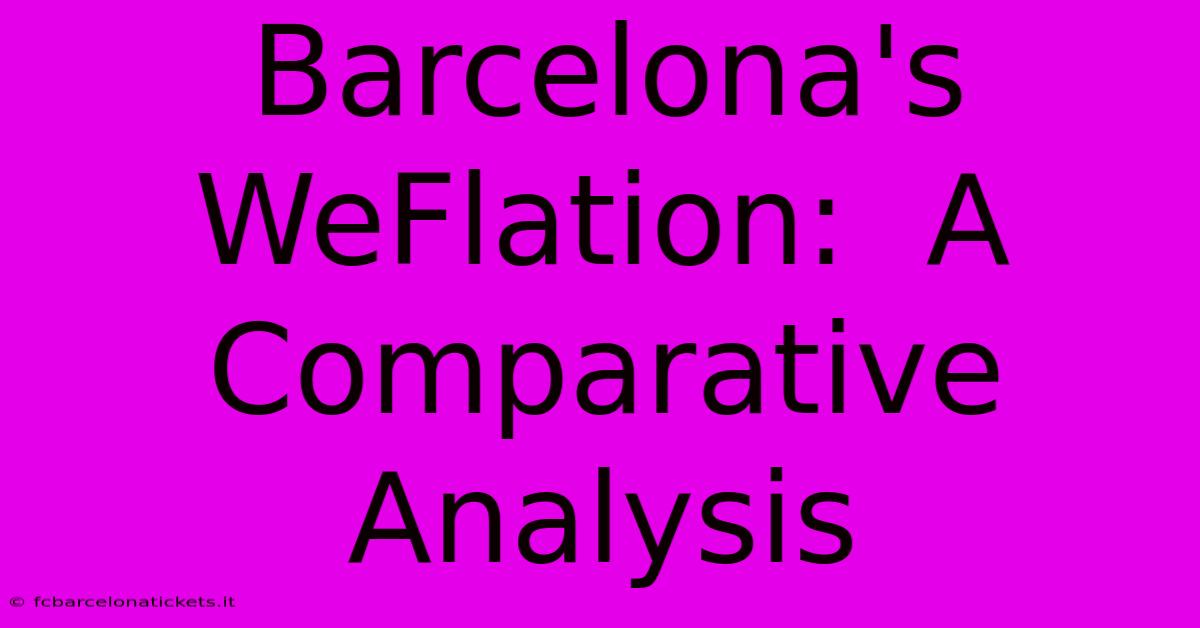Barcelona's WeFlation: A Comparative Analysis

Table of Contents
Barcelona's WeFlation: A Comparative Analysis
Barcelona, a city known for its vibrant culture and innovative spirit, is increasingly becoming a focal point for discussions surrounding "WeFlation." This economic phenomenon, characterized by widespread inflation driven by increased consumer demand fueled by government stimulus, presents unique challenges and opportunities. This article will delve into a comparative analysis of WeFlation in Barcelona, contrasting it with other major cities and exploring its implications.
Understanding WeFlation in the Barcelona Context
WeFlation, unlike traditional inflation driven by supply-side shocks, arises from a surge in consumer spending often triggered by substantial government intervention. In Barcelona's case, factors such as post-pandemic recovery initiatives, tourism resurgence, and potentially specific local government policies may have contributed to the pressures of WeFlation. It's crucial to understand that Barcelona's WeFlation experience is not isolated; it's part of a broader global trend, but its unique characteristics warrant specific investigation.
Key Factors Contributing to WeFlation in Barcelona:
- Tourism Boom: Barcelona's robust tourism sector, a significant contributor to its economy, experienced a massive rebound post-pandemic. This influx of tourists drove up demand for goods and services, pushing prices higher.
- Government Spending: Post-pandemic recovery packages and other government initiatives aimed at stimulating the economy may have inadvertently fueled increased consumer demand, contributing to inflationary pressures.
- Housing Market Dynamics: The competitive Barcelona housing market, characterized by high demand and limited supply, also plays a role in overall inflation, impacting the cost of living and contributing to WeFlation.
- Supply Chain Issues: While WeFlation is demand-driven, lingering global supply chain disruptions have exacerbated price increases in Barcelona, making the situation more complex.
Comparing Barcelona's WeFlation to Other Cities
To gain a deeper understanding of Barcelona's WeFlation, comparing it to other major cities experiencing similar trends is essential. While a direct, apples-to-apples comparison is difficult due to varying economic structures and government policies, certain parallels and divergences can be identified.
Barcelona vs. Other European Capitals:
Cities like Paris, London, and Madrid also grapple with inflationary pressures. However, the specific drivers of inflation might differ. For example, London's inflation might be more heavily influenced by Brexit-related issues, while Paris might experience different pressures related to its energy sector. A comparative analysis should examine the relative contributions of factors like tourism, government spending, and supply chain issues in each city to identify unique characteristics.
Barcelona vs. Cities in Other Regions:
Comparing Barcelona to cities in different regions, such as New York City or Tokyo, reveals further insights. Differences in economic structures, demographics, and governmental responses to economic challenges will yield diverse WeFlation experiences. For instance, the impact of technology and globalization might be more pronounced in New York City compared to Barcelona.
The Implications of WeFlation in Barcelona
WeFlation in Barcelona has profound implications for various aspects of its economy and society. Understanding these implications is crucial for formulating effective policy responses.
Impact on Consumers:
Rising prices directly impact consumers' purchasing power, potentially leading to decreased consumer confidence and reduced spending. This could have ripple effects throughout the Barcelona economy.
Impact on Businesses:
Businesses face challenges in managing rising costs, potentially impacting profitability and investment decisions. The ability to pass on increased costs to consumers is a critical factor determining business resilience during WeFlation.
Policy Responses:
The Barcelona city government needs to employ a multifaceted approach to mitigate WeFlation. This could include measures such as targeted subsidies for vulnerable populations, investments in infrastructure to boost supply, and fiscal policies to moderate consumer demand without stifling economic growth.
Conclusion: Navigating Barcelona's WeFlationary Landscape
Barcelona's WeFlation presents both challenges and opportunities. While inflationary pressures pose risks to economic stability and consumer well-being, addressing them effectively can lead to a more resilient and sustainable economic future. Further research, encompassing detailed data analysis and comparative studies with other global cities, is crucial to developing robust and effective policy responses to navigate this complex economic landscape. Understanding the specific drivers of WeFlation in Barcelona, in contrast to other cities, is key to developing targeted and impactful solutions.

Thank you for visiting our website wich cover about Barcelona's WeFlation: A Comparative Analysis. We hope the information provided has been useful to you. Feel free to contact us if you have any questions or need further assistance. See you next time and dont miss to bookmark.
Featured Posts
-
Rejuvenation Treatments Massages In Barcelona
Apr 03, 2025
-
Barcelona Jerseys Quality You Can Trust
Apr 03, 2025
-
Barcelona Gse Forum Networking Opportunities Abound
Apr 03, 2025
-
Barcelona Beyond The Taxi Strike
Apr 03, 2025
-
Launch Your Barcelona Venture With Confidence
Apr 03, 2025
